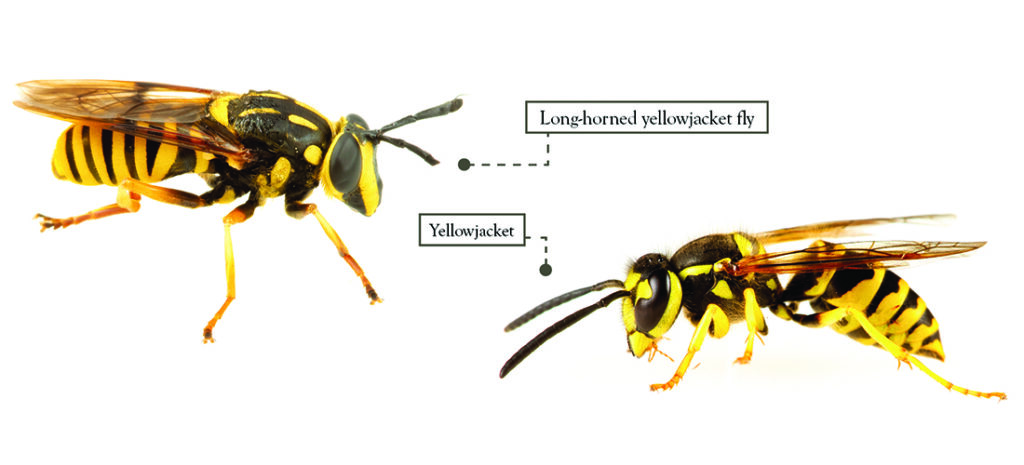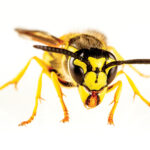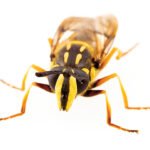Naturalist

The Fly in Wasp’s Clothing
The best costumes are made by Mother Nature
Story and Photographs by Todd Pusser
Staring through a macro lens at the critter resting in the center of my photo tent, I have to constantly remind myself that I am not going to get stung. With large eyes and striking black and yellow markings, it looks for all the world like a wasp — a yellowjacket, to be more precise. Only when it rubs its forelimbs over its eyes does it begin to reveal its true identity. It is a rarely observed type of hover fly and a perfect doppelganger for the venomous wasp.
The day before, Floyd Williams, a retired ranger from Merchants Millpond State Park with a keen naturalist’s eye, captured the fly in his yard in Gates County. Well aware of my interest in unusual animals, he phoned to inform me of his prize, the Sphecomyia vittata. Not being well-versed in the scientific names of flies, a quick Google search revealed a much more manageable common name, the long-horned yellowjacket fly.
Like most people, I have never given flies much thought, other than when I am trying to shoo one out the car window or when I slap a deer fly taking a nibble from the back of my neck. Aside from politicians, and perhaps the Duke men’s basketball team, flies are among the most detested of all living things.
Yet for all the public apathy, flies are vital components of a healthy ecosystem. Need something to break down that pile of dog poop in the backyard? There’s a fly for that. Need something to pollinate those bright flowers in the garden? There’s a fly for that. How about ridding insect pests that raid those same gardens? You guessed it. There’s a fly for that. Sporting an infinite array of shapes and sizes, flies provide a wealth of underappreciated environmental services.
As I fiddle with my exposure, the hover fly begins to slowly walk across the floor of the photo tent. Reaching inside, I gently prod the fly with a toothpick, in an effort to move it to the center of the tent, back into camera range. Upon feeling the nudge to its abdomen, the fly suddenly lets out a sharp and unexpected buzz. I marvel. Not only does this fly look like a yellowjacket, it sounds like one too! The buzz only adds to the illusion. As far as mimics go, this one takes the top prize.
Flies of every kind are eaten by a plethora of animals. Spiders, birds, lizards, small mammals, even wasps relish a juicy fly. If one is going to fly about out in the open, during daylight hours, as hover flies (aka flower flies) do, it pays to look like something unappetizing, or better yet, dangerous.
Defenseless organisms that masquerade as dangerous ones employ an evolutionary survival strategy that biologists refer to as Batesian mimicry. Named for the Victorian naturalist Henry Walter Bates, who spent years trouncing around the forests of the Amazon and first discovered the natural phenomenon, this form of mimicry is surprisingly common. Most of the 6,300 or so species of hover flies found around the world bear a striking resemblance to wasps and bees.
Finishing up my session, I take the photo tent outside and open the side panel. With the toothpick, I gently nudge the wings of the hover fly, coaxing it to take off. In a flash, the fly zips out of the photo tent and lands a few yards away on the purple flowers of a backyard butterfly bush, perhaps needing a refreshing sip of nectar after its glamour shots. A five-lined skink, lounging on the railing of our deck, next to the flowers, pays it no mind. Nor does a cardinal singing nearby.
Later, scrolling through the photos on my computer screen, I find myself full of childlike wonder, once again marveling at the extraordinary resemblance of the hover fly to a yellowjacket. Even zooming in on the details of the legs, antennae and body, I find it difficult to establish that it is indeed a fly.
The optical illusion serves to drive home an important lesson: One need not travel to some distant or remote tropical jungle to discover remarkable wonders in nature. The wild right outside the front door is just as full of extraordinary creatures, if one only stops and takes the time to look. PS
Naturalist and photographer Todd Pusser grew up in Eagle Springs. He works to document the extraordinary diversity of life both near and far. His images can be found at www.ToddPusser.com.


